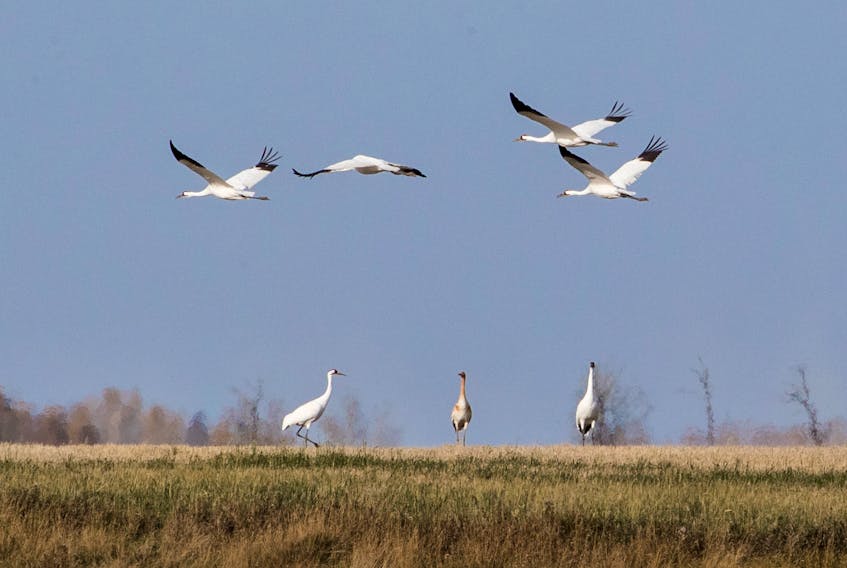Saskatchewan is not the first place that comes to mind as an option for a week-long vacation in October for most people.
The quest of a birder frequently takes them to roads less travelled. If you want to see the critically endangered whooping crane in Canada then Saskatchewan in October is the place to be. Whooping cranes have been one of the most threatened species of birds in North America for more than 100 years. Their nesting range is restricted to Wood Buffalo National Park which straddles the Alberta and Northwest Territories border. Their winter range is even more restricted to the Aransas National Wildlife Refuge on the Gulf Coast of Texas. Their narrow migration route between the two locations is done with very little stopping in between.

However, the first stop after leaving the nesting grounds in early fall is Saskatchewan. Most of the whoopers stop here for several weeks to fuel up on waste grain in the agricultural farmlands. Traditionally they choose a location within a 100-km radius of Saskatoon. They can occur anywhere within this circle. They often use the same areas for a couple of consecutive seasons then move to another for the next few years. They arrive in Saskatchewan in late September and leave by early November with the peak time of occurrence being Oct. 5-20.
I had done a Saskatchewan whooping crane trip in 2009. It was successful and enjoyable trip with three of the great cranes observed. In 2019 it was time to do it again. This time I would have my brother Andrew for company.
The news was good in the days leading up to our Oct. 13 arrival at Saskatoon. There had been reports of up to 50 whooping cranes near the tiny farming town Marcelin an hour or so drive north of Saskatoon. We had four hours of daylight after getting our rental car airport. Without knowing exactly which side road to take, we took a chance on one of them and within five minutes we saw two tall snow white birds standing in a golden-yellow recently cut wheat field.
Binoculars showed us there was a rusty coloured juvenile bird with the pair.
Whooping cranes are the largest bird in Canada, with a long white neck.
With the spotting scope we could see the red skin around their face. They strut with an air of nobility poking at the ground for kernels of waste wheat and any stray grasshopper-size insects that make the mistake of showing themselves.
Elated by our immediate success we could hear more and were drawn to a shallow lake with a broad marshy border. With spotting scopes we counted 64 whooping cranes standing in the shallows and feeding in the adjacent wheat fields.
We drove around on other roads adding more to our tally. The last three were just before dark. It was another pair of adults with a rusty coloured young.
Even at 300 metres the birds were anxious. The adults called nervously to each other as they pecked at the ground walking at a steady pace directly away. Their bugle is the loudest sound produced by any bird in North America. It was the only sound breaking the profound silence of the evening prairie. There were no highways or civilization close enough to be heard. It was likely part of the reason the cranes had chosen this as their fall staging area. We had tallied a staggering 110 whooping cranes, roughly one quarter of the wild population of whooping cranes
We spent all of the next day and part of two more with the cranes.
They were exceedingly wary. Even a car stopping on the road could cause cranes to flush at 500 metres. They avoided flying over humans. The photographs were all distant but views with the spotting scope were quite satisfying. The little used grid roads lined with aspen trees bordering the huge golden wheat fields interspersed with prairie ponds created an enchanting scene perfect for such an untouchable bird.
There were more than the whooping cranes to see in Saskatchewan. We had no trouble filling up each day of the week with birding opportunities.
October is goose migration month in the prairies. The enormous flocks of snow geese were mind boggling. Canada geese, Ross’s geese and white-fronted geese were also abundant. Even the tundra swan was common.
One of the greatest birding spectacles I have ever witnessed was when a bald eagle flew over a wheat field containing 30,000-40,000 grazing snow geese. The ensuing chaos was astonishing.
The sound of that many panicked geese almost lifted us off the ground. The mesmerizing movement of walls of geese moving in different directions at different distances from us was paralyzing.
We stood there in awe with cameras hanging limp at our sides not knowing what to do.
Saskatchewan is a thrill a day destination for Canadian birders during the month of October.
Bruce Mactavish is an environmental consultant and avid birdwatcher. He can be reached at [email protected].
RELATED:









